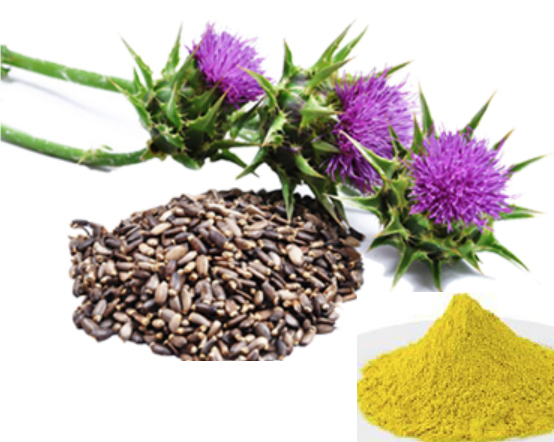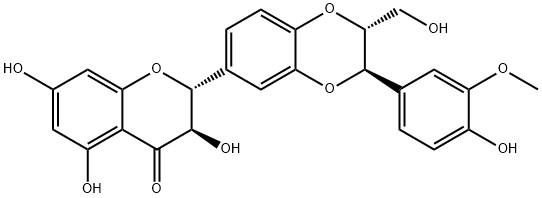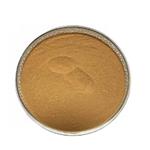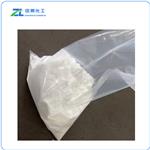Description
Silybin, also known as silibinin, is the principal biologically active constituent of the silymarin complex (about 70–80%) and is a mixture of silybin A and silybin B. Pharmacological research demonstrated that silybin has shown pleiotropic biological properties, including potent antioxidant, anti-inflammatory, anticancer, antidiabetic, hepatoprotective, neuroprotective, antiviral, antimicrobial and immunosuppressive activities. Silibinin demonstrates promising anticancer effects in vitro and in vivo[1].

Chemical Properties
solid
Originator
Legalon,Madaus,W. Germany,1969
Uses
Labelled Silybin (S465850). Hepatoprotectant.
Uses
Silibinin has been used:
- to study its effect on gene expression levels of various proteins involved in chromatin regulations of prostate cancer, by real time polymerase chain reaction (RT-PCR)
- to study its effect on cell proliferation in platelet-derived growth factor (PDGF)-treated human tenon′s fibroblasts (HTFs) by investigating the expression of proliferating cell nuclear antigen (PCNA) and by water-soluble tetrazolium salt (WST-1) assay
- to examine its effect on gene expression levels of stromelysine 1 (STM1), acetyl hexoseamines and collagen production during skin wound healing
- to study its inhibitory effect on Escherichia coli ATP synthase
Definition
ChEBI: A flavonolignan isolated from milk thistle, Silybum marianum, that has been shown to exhibit antioxidant and antineoplastic activities.
Manufacturing Process
Silymarin comprising polyhydroxyphenyl chromanones is recovered from the
dried fruit of Silybum marianum Gaertn. by separating the fatty oils
therefrom, extracting the remaining solid residue with ethyl acetate,
evaporating the ethyl acetate and dissolving the dry residue in a solvent
mixture comprising methanol, water and petroleum ether to form a two-phase
system wherein the chromanones are contained in the lower phase,
recovering the polyhydroxyphenyl chromanones from the lower phase after
subjecting same to multiple counter-current contact with petroleum ether.
Therapeutic Function
Hepatoprotectant
Biological Functions
Silybin has excellent therapeutic effects on EAE by inhibiting the polarization of Th1. Moreover, it has been proven to protect pancreatic β-cells, attenuate hepatic glucose production, and increase glucose uptake in muscle in vitro and in vivo. Glucokinase (GK) and PPARγ are essential targets for antidiabetic use. Silybin was an agonist of GK and PPARγ. It could improve glycemic homeostasis by improving the activity of pancreatic β,-cells, increasing insulin sensitivity of liver and muscle cells, and decreasing lipid deposition in adipocytes. The molecular mechanisms of silibinin-mediated antiproliferative effects are mainly via receptor tyrosine kinases, androgen receptors, STATs, NF-&kappa, B, cell cycle arrest, and apoptosis/autophagy-inducing signaling pathways in various cancer cells. Next to modulating the NF&kappa signaling pathway, Sibilin inhibits NLRP1/NLRP3 inflammasome signaling pathways. It modulates many molecular changes caused by xenobiotics and ultraviolet radiation to protect the skin and is used in cosmeceutical preparations[2].
General Description
Silibinin, a principal component of silymarin, is a flavonolignan and an orally active flavonoid. It is isolated from the seeds of milk thistle (
Sylibum marianum L).
Biochem/physiol Actions
Silibinin (Silybin) functions as a hepatoprotectant in patients with acute and chronic liver injury. This flavonoid fights against various cancer cells including, prostate, skin, breast, colon, lung, bladder and hepatocellular carcinoma (HCC). Silibinin exhibits its efficacy as an anti-cancer agent by blocking the secretion of proangiogenic factors from tumor cells, and by hindering growth and inducing apoptotic death of endothelial cells. In addition, it also interrupts capillary tube formation on Matrigel. Silibinin might be a good candidate for chemoprevention of prostate cancer (PC). It might be used as a potential therapeutic regimen for the treatment of endometriosis in vitro and in vivo.
References
[1] Huan-Li Yang, Xiao-Wu Shi. “Silybin Alleviates Experimental Autoimmune Encephalomyelitis by Suppressing Dendritic Cell Activation and Th17 Cell Differentiation.” Frontiers in Neurology (2021): 659678.
[2] Zhipeng Zhang. “Discovery of Potent Glucokinase and PPARγ Dual-Target Agonists through an Innovative Scheme for Regioselective Modification of Silybin.” ACS Omega 7 4 (2022): 3812–3822.
[3] Romanucci, Valeria et al. “7-O-tyrosyl Silybin Derivatives as a Novel Set of Anti-Prostate Cancer Compounds.” Antioxidants 38 1 (2024).





